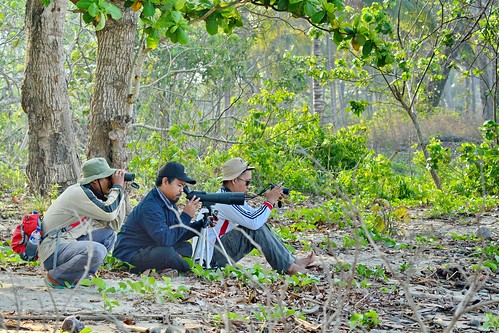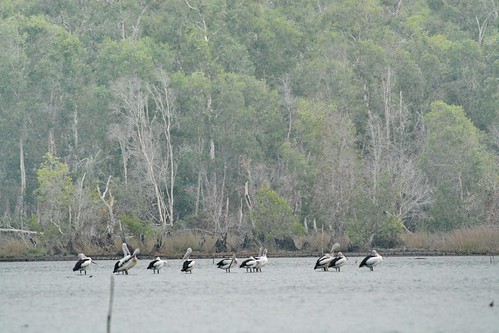A report by Ramli, Wasur National Park [EAAF008]
and Yus Rusila Noor, Wetlands International Indonesia

© Alwi/Balai TN Wasur
As part of the regular management of the national park area, a team of the Forest Ecosystem Control Functional Staff of Ministry of Environment and Forestry has carried out a monitoring of waterbirds in Wasur National Park, Papua – Indonesia. The monitoring aimed on updating the National Park’s inventory on biodiversity population as part of the on-going national park management system. The data collection is done over four days during the last week of December 2016, during which observations were made at predetermined transects in the Ndalir sector , and with more detailed observations for 15-20 minutes at the location where significant population of birds are observed.

© Alwi/Balai TN Wasur
Wasur National Park is located at the eastern tip of Indonesia with an area of approximately 436,000 hectares, consisting mostly of wetlands habitat. At least 424 species of birds has been recorded, including 74 species of which are endemic of Papua, and 114 species which are protected by the Government of the Republic of Indonesia. The national park is considered as an important site for the “Trans Fly” vision because it is located on the border of the two countries, Indonesia and Papua New Guinea, which supports the central region of New Guinea avifauna. Because of its role as a wetland of international importance, especially as habitat for waterbirds, Wasur National Park has been designated by the Government of Indonesia as Ramsar site as well as a network site of East Asian-Australasian Flyway Partnership.

 © Alwi/Balai TN Wasur
© Alwi/Balai TN Wasur
The results of these observations re-confirmed the importance of Wasur National Park for waterbirds, especially migratory waterbirds. At least 33 species of 1,800 individual waterbirds observed during the 4 days observation. The most commonly observed shorebirds include Grey-tailed Tattler Heteroscelus brevipes, White-headed Stilt Himantopus leucocephalus, Far-eastern Curlew Numenius madagascariensis, Whimbrel Numenius phaeopus, Red-necked Stint Calidris ruficollis, and Black-tailed Godwit Limosa limosa. Meanwhile, the larger waterbirds are including Australian Pelican Pelecanus conspicillatus, Little Black Cormorant Phalacrocorax sulcirostris, Royal Spoonbill Platalea regia, Masked Lapwing Vanellus miles and Anatidae species, such as Pacific black Buck Anas superciliosa and Plumed Whistling Duck Dendrocygna eytoni.
The following recommendations are proposed to improve the management of Wasur National Park, especially in relation to biodiversity monitoring programme:
- Regular protection measures, including hunting, are required in the Coast of Kuller, Onggaya and around Kampung Tomer regions;
- Stricter control of invasive plant species in Rawa Dogamit, which currently covered almost half of the water bodies;
- During this survey, the Dogamit swamp water appears to be becoming saltier. It is urgently required to study the seawater intrusion and salinity levels;
- Regular, ideally onthly observations are needed to determine the changes in migratory (and resident) waterbird populations, so that their annual population and variations could be better understood;
- There needs to be cooperation with other parties, particularly with experts, to monitor the status and condition of biodiversity and population dynamics;
- Given the current limited facilities available, it is necessary to procure additional equipment for species identification and inventory (field guides, binoculars, telescopes, cameras, GPS,) as well as other survey equipment, such as mist-nets and bird-banding kits;
- Additional training for National Park Staff, particularly related to species identification, observation and survey methods, bird banding, behavioral analysis and report writing.
Reported by: Ramli – Forest Ecosystem Control Functional Staff, Wasur National Park, Merauke, Papua and Yus Rusila Noor – Wetlands International Indonesia




